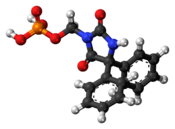Fosphenytoin
 | |
 | |
| Clinical data | |
|---|---|
| Trade names | Cerebyx |
| AHFS/Drugs.com | Monograph |
| MedlinePlus | a604036 |
| Routes of administration | Intravenous, intramuscular |
| ATC code | |
| Legal status | |
| Legal status | |
| Pharmacokinetic data | |
| Bioavailability | 100% (IM) |
| Protein binding | 95–99% |
| Metabolism | Liver |
| Elimination half-life | 15 minutes to convert to phenytoin |
| Excretion | Kidney (as phenytoin) |
| Identifiers | |
| |
| CAS Number | |
| PubChem CID | |
| IUPHAR/BPS | |
| DrugBank | |
| ChemSpider | |
| UNII | |
| KEGG | |
| ChEMBL | |
| CompTox Dashboard (EPA) | |
| Chemical and physical data | |
| Formula | C16H15N2O6P |
| Molar mass | 362.274 g/mol g·mol−1 |
| 3D model (JSmol) | |
| |
| |
| | |
Fosphenytoin (fosphenytoin sodium, trade names Cerebyx, Parke-Davis; Prodilantin, Pfizer Holding France[2]) is a water-soluble phenytoin prodrug that is administered intravenously to deliver phenytoin, potentially more safely than intravenous phenytoin. It is most commonly used in the acute treatment of convulsive status epilepticus.
Fosphenytoin was developed in 1996.[3] On 18 November 2004, Sicor (a subsidiary of Teva) received a tentative approval letter from the United States Food and Drug Administration for a generic version of fosphenytoin.[4]
Medical uses
Fosphenytoin is approved in the United States for the short term (five days or fewer) treatment of epilepsy when more widely used means of phenytoin administration are not possible or are ill-advised,[5] such as endotracheal intubation, status epilepticus or some other type of repeated seizures; vomiting, and/or the patient is unalert or not awake or both.[6]
Other
In 2003, it was reported that even though anticonvulsants are often very effective in mania, and acute mania requires rapid treatment, fosphenytoin had no antimanic effect.[7]
Metabolism
One millimole of phenytoin is produced for every millimole of fosphenytoin administered; the hydrolysis of fosphenytoin also yields phosphate and formaldehyde, the latter of which is subsequently metabolized to formate, which is in turn metabolized by a folate dependent mechanism.[5]
Side effects
Side effects are similar to intravenous phenytoin and include hypotension, cardiac arrhythmias, CNS adverse events (nystagmus, dizziness, sedation/somnolence, ataxia and stupor), and local dermatological reactions. Purple glove syndrome probably occurs with fosphenytoin but possibly at lower frequency than with intravenous phenytoin. Fosphenytoin can cause hyperphosphatemia in end-stage renal failure patients.[8]
History
Phenytoin, in both its acidic and sodium salt forms, is erratically bioavailable whether it is injected or taken orally due to its high melting point, weak acidity, and its being only sparingly soluble in water.[9] Simply putting patients on other drugs is not always an option; this was especially true before 1993, when the number of anticonvulsants available was much more limited.[10] One solution was to develop a prodrug that did not have these drawbacks.
Fosphenytoin was approved by the Food and Drug Administration (FDA) on August 5, 1996 for use in epilepsy.[11]
References
- ^ "FDA-sourced list of all drugs with black box warnings (Use Download Full Results and View Query links.)". nctr-crs.fda.gov. FDA. Retrieved 22 Oct 2023.
- ^ "PRODILANTIN 75 mg/ml sol inj IM et p perf IV". VIDAL, l'information de référence sur les produits de santé. Retrieved 23 October 2005.
- ^ Pitkänen, Asla; Schwartzkroin, Philip A.; Moshé, Solomon L. (2005). Models of Seizures and Epilepsy. Burlington: Elsevier. p. 539. ISBN 9780080457024.
- ^ "Fosphenytoin Sodium Approval History". Retrieved 20 October 2005.
- ^ a b Parke-Davis (2001). "Cerebyx: Fosphenytoin Sodium Injection - Labeling Revision" (PDF). Cerebyx Approval History. Warner-Lambert Company. Archived from the original (PDF) on October 17, 2003. Retrieved 20 October 2005.
- ^ Johnson J, Wrenn K (2001). "Inappropriate fosphenytoin use in the ED". American Journal of Emergency Medicine. 19 (4): 293–4. doi:10.1053/ajem.2001.24471. PMID 11447516. Fulltext options List of Library Holdings Worldwide
- ^ Applebaum J, Levine J, Belmaker RH (2003). "Intravenous fosphenytoin in acute mania". Journal of Clinical Psychiatry. 64 (4): 408–9. doi:10.4088/JCP.v64n0408. PMID 12716241.
- ^ McBryde KD, Wilcox J, Kher KK (2005). "Hyperphosphatemia due to fosphenytoin in a pediatric ESRD patient". Pediatric Nephrology (Berlin, Germany). 20 (8): 1182–5. doi:10.1007/s00467-005-1947-0. PMID 15965770.
- ^ Yamaoka Y, Roberts RD, Stella VJ (April 1983). "Low-melting phenytoin prodrugs as alternative oral delivery modes for phenytoin: a model for other high-melting sparingly water-soluble drugs". J Pharm Sci. 72 (4): 400–5. doi:10.1002/jps.2600720420. PMID 6864479.
- ^ Anticonvulsants before 1993 Neuroland
- ^ "Cerebyx Approval History". Retrieved 20 October 2005.
